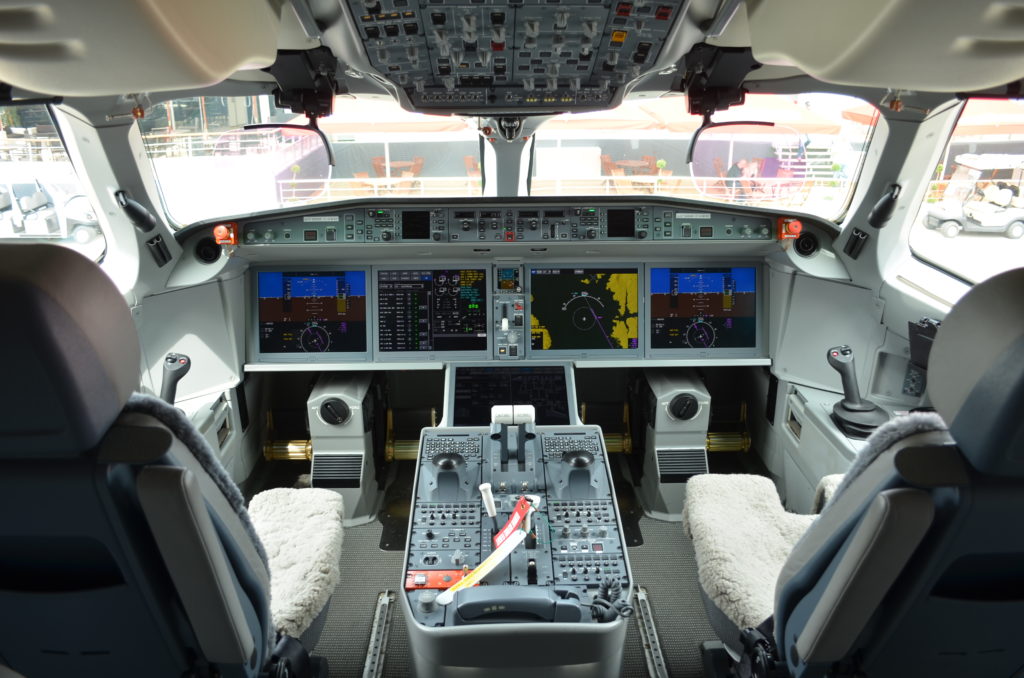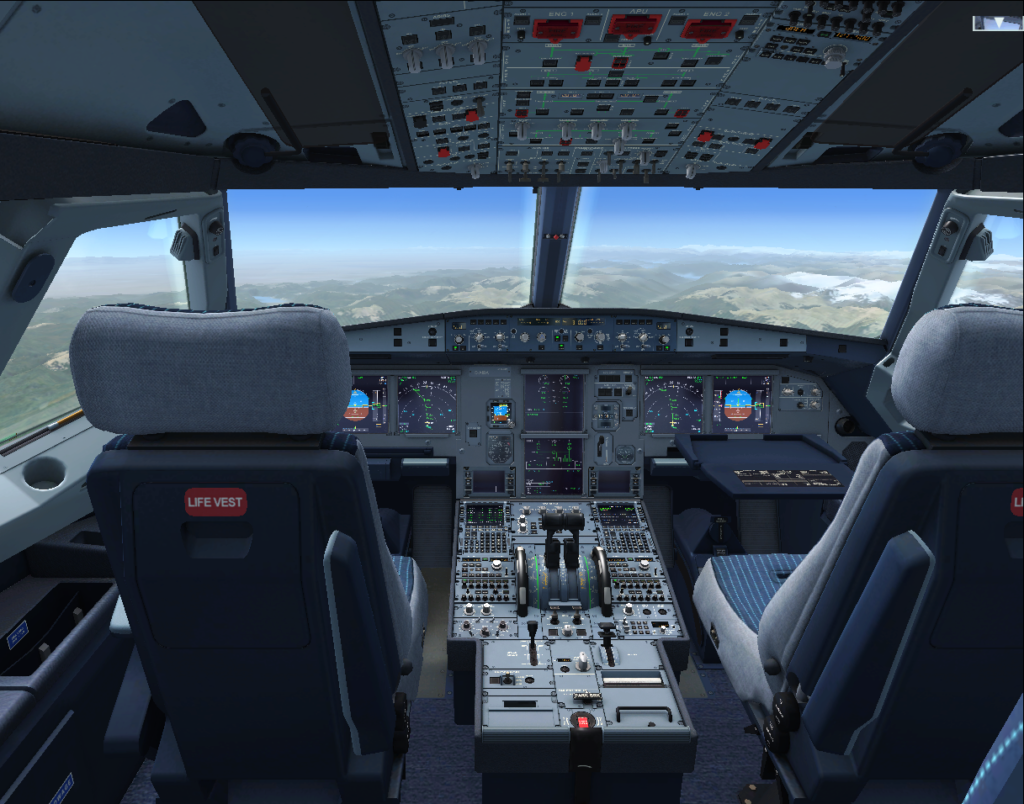Leeham News and Analysis
There's more to real news than a news release.
Leeham News and Analysis
Bjorn’s Corner: C Series flight controls
29April 2016, ©. Leeham Co: With the order by Delta Air Lines, the Bombardier C Series has taken the step up to be a viable alternative to Airbus’ and Boeing’s single aisle 130-150 seat aircraft.
In my description of airliners’ flight control and Flight Management Systems (FMS), I have focused on the established mainline single aisle players. Time to change that; C Series has arrived and will stay in the mainline segment.
Why 130 seats as a limit? Because below 130 seats there are a number of additional players (Embraer, Sukhoi, Mitsubishi…) and we can’t describe them all right now.
Now to how Bombardier has implemented the flight controls, autopilot and FMS for the C Series. In fact, we will look at how they have made the C Series cockpit, Figure 1.
I haven’t flown the C Series yet (working on it!) but I have been able to glean quite a bit over time and spent quite some time in the cockpit with the Bombardier test pilots at the Paris Air Show.
So here is a shot at describing the C Series control philosophies and capabilities and how they mimic/differ from Airbus and Boeing.
Posted on April 29, 2016 by Bjorn Fehrm
Bjorn’s Corner: We fly to Nice
22 April 2016, ©. Leeham Co: Last week we described the function of the aircraft’s Flight Management System, FMS. Now we will use the FMS to program a flight between Innsbruck in Austria and my hometown Nice on the French Riviera.
To make it practical and easy to follow, we will focus on how the Flightplan that we have programmed into the FMS will be processed. To follow that, we look at the display of the FMS navigation on the aircraft’s navigation display. There, one can follow how the FMS and Autopilot work through all the information that a flight-planned mission contains.
The cockpit we see in the picture is the aircraft we will use, an A319 that we have borrowed for the day from Lufthansa, just to help us understand how navigation with a FMS works. It is of course not a real aircraft, but it’s not far from it.
The best flight simulators that are available for your PC today are extremely well done and realistic; this is one of them. It’s an A319 simulator from the German company Aerosoft. I flew the mission for us yesterday.
Let’s see how it works.
Posted on April 22, 2016 by Bjorn Fehrm
Bjorn’s Corner: The role of a Flight Management System
15 April 2016, ©. Leeham Co: In several of my Corners when describing flight control systems and autopilots for airliners, I have written about the aircraft’s Flight Management System (FMS) without actually describing its role completely.
The first complete FMS was introduced with the Boeing 767 in 1982. Before the Boeing 767, aircraft cockpits had at least three flight crew members, the third being the navigator or flight engineer. This third person managed a number of tasks. He surveyed the aircraft’s systems/engines and performed the navigation for the aircraft.
With the introduction of computerized support systems for system monitoring and warning (EICAS for Boeing, ECAM for Airbus) and navigation (FMS for both Boeing and Airbus), the third person could be replaced and two flight crew cockpits became the norm.
When flying a modern airliner, the FMS has a central role in both flight preparations and during flight. We will therefore describe what an FMS does in more detail. Read more
Posted on April 15, 2016 by Bjorn Fehrm
Bjorn’s Corner: Embraer’s Fly-by-wire approach
08 April 2016, ©. Leeham Co: Two weeks ago we discussed the advantages of a Fly-By-Wire (FBW) system which uses feedback based flight laws. We discussed the fact that aircraft OEMs can get the desired FBW handling characteristics with smaller horizontal tail surfaces. I put forward the Embraer E-Jets as an example where the change of FBW principle allowed a 26% reduction in the horizontal tail size for the E2 generation.
At the time there were some debate on how this was achieved and what the root cause of the improvement was. Embraer followed the discussion and told me when I contacted them that my information was correct. In the interest of our readers, Embraer agreed, however, to have their FBW team to give a more complete picture of the advantages of a feedback based FBW.
Here is the team’s response. Read more
Posted on April 8, 2016 by Bjorn Fehrm
Bjorn’s Corner: Flight control, Part 4
1 April 2016, ©. Leeham Co: Last week we described the computer augmented flight controls that are possible with Fly-By-Wire (FBW) systems. We described the most common flight control laws by discussing the two most common control law implementations in the market, the Airbus and the Boeing ones.
Today we will finish the series by discussing how an autopilot, or as the OEMs call it, an Autoflight or Automatic flight system, is added to the aircraft’s control system. An autopilot is most of the time combined with a flight director and a Flight Management System (FMS).
We will mention how these fit in the picture but focus on the autopilot, once again to keep it simple and avoid trying to cover too much. The autopilot subject is large enough. Read more
Posted on April 1, 2016 by Bjorn Fehrm
Bjorn’s Corner: Flight control, Part 3
25 March 2016, ©. Leeham Co: Last week we covered the natural stability of commercial aircraft and the most important movements the aircraft would go into if we had no pilot intervention.
Now we will cover how Fly-By-Wire (FBW) systems make enhanced flight control laws practical to implement. We will cover the principal build up of a FBW system with enhanced control laws and two of the most common approaches used in the market for such control laws: the Airbus and the Boeing implementations.
The discussion will focus on the essential and forgo many deeper discussions over redundancy and safety. Otherwise the subject expands into a book rather than an easy to read article and that is not what we want.
Posted on March 25, 2016 by Bjorn Fehrm
Bjorn’s Corner: Flight control, Part 2
18 March 2016, ©. Leeham Co: Last week we covered the early days of flight control when the pilot controlled the aircraft’s movable surfaces (called movables; e.g. stabilator, rudder, ailerons, spoilers…) without the involvement of computers.
We will now continue with more advanced control systems, all based on the electrical signalling of the intentions of the pilot to the movables. As the modern Fly-By-Wire (FBW) control systems modify the aircraft’s basic flying behaviour, we need to start with understanding what that behaviour is. Then we can understand how different FBW systems go about modifying these characteristics.
One could think that an aircraft is made to fly nice and stable, should the pilot take a few seconds and admire the view. Nothing could be further from reality. All normally stable aircraft which do not employ flight computers or autopilots to enhance the normal stability would go into a rather nasty dive after a while.
Why this is so and what is done to help the pilot in modern FBW systems is the subject of today’s and next week’s Corner.
Posted on March 18, 2016 by Bjorn Fehrm
Bjorn’s Corner: Flight control
11 March 2016, ©. Leeham Co: We covered a bit on flight testing some Corners ago and the fact that test pilots like to fly in direct Fly-By-Wire mode for initial evaluation of the aircraft. There’s a lot to say about how an aircraft is controlled. I have experienced the significant shift from mechanical flight controls to Fly-By-Wire (FBW).
For the pilot, things haven’t changed that much for normal flying with the introduction of FBW, but for the aircraft manufacturer it’s a dramatic change. It changes the way how one works to get an aircraft to fly nicely within its whole speed and altitude register (called the aircrafts flight envelope).
We will cover the reasons for the changeover to FBW for commercial aircraft and what this enables in a couple of Corners. We will start with how the classical mechanical flight control gradually got itself into more and more complication and how this was solved with FBW.
In a subsequent Corner, we will look at how FBW enable us to fly the aircraft differently. We can with the help of FBW implement more sophisticated flight control laws, aimed at helping the pilot to a safer flight.
Posted on March 11, 2016 by Bjorn Fehrm
Bjorn’s Corner: Engine architectures
 4 March 2016, ©. Leeham Co: There is a saying, “There’s more than one way to skin a cat.” The same goes for making successful Turbofans to commercial aircraft.
4 March 2016, ©. Leeham Co: There is a saying, “There’s more than one way to skin a cat.” The same goes for making successful Turbofans to commercial aircraft.
At the recent Pacific Northwest Aerospace Alliance 2016 sub-supplier conference in Seattle, GE, Rolls-Royce and Pratt & Whitney all talked about their latest engine projects and the technology development that was critical to their success.
The engines they talked about, the GE9x, Rolls-Royce Advance and Pratt & Whitney’s Geared Turbofan, can all be characterised as the best of breed for their intended use but they could not be more different in how their level of excellence is achieved.
It made for interesting listening. Here’s the gist of what was told.
Posted on March 4, 2016 by Bjorn Fehrm
Bjorn’s Corner: Flight tests
19 February 2016, ©. Leeham Co: Last week I described how Mitsubishi Aircraft Corporation (MAC) issued a press release on Christmas day communicating MAC would be doing structural reinforcements on their test airframes before continuing flight testing. MAC was perhaps overzealous when informing the world that they would do minor reinforcements to two ribs and a few stub spars in order to pass Ultimate strength tests for the aircraft.
I rightfully thought this is the Japanese culture at play; there must not be a big problem behind it.
There was one more area of that press release that intrigued me. Here what it said: “The first flight and the subsequent flight tests have confirmed the basic characteristics to be satisfactory. However, we also have recognized several issues as we attempt to accelerate our development.”
Time to decrypt this as well and compare to what has become standard industry practice.
Posted on February 26, 2016 by Bjorn Fehrm



